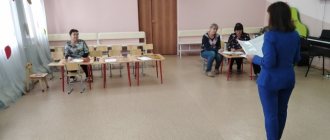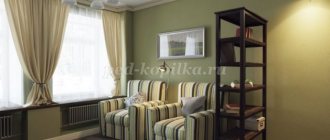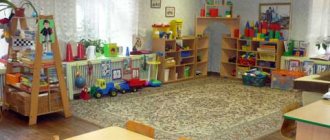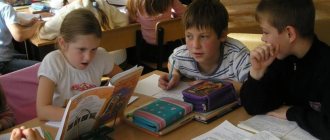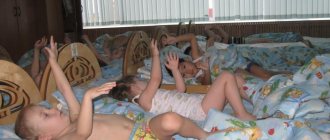Names of corners in kindergarten, list
For preschoolers, kindergarten is their second home, because most of the time on weekdays, when parents are at work, they are in this educational institution. It is very important that they feel comfortable and warm in the kindergarten.
We recommend that all educators organize corners according to the list below:
- First of all, it should be a corner that indicates the name of the group, the age category of the children who attend it, as well as a photo of the children and an emblem. For example, if the group is called “Sun,” let the image of the sun be the emblem. If you want, you can attach a list of all the children here.
- Information stand for parents. Here every mother and father can find information about the curriculum that the children are undergoing, their daily routine, activity plan and group news. It would be very good if information about the parent committee and contact information for teachers, nurses and the head of the kindergarten are also available here.
- Do-it-yourself corner. On it, educators can display children's creative works. When new drawings or crafts appear, old ones can be given to parents or put in a special folder that will serve as a portfolio.
- Study corner. There should be alphabets that children study, numbers, copybooks, a globe and other other objects and stationery that children use in class.
- A green corner is a place where you can post information about why it is important to protect nature and how to do it correctly. Place homemade flowers in pots here. They will not only decorate the interior, but will also allow you to maintain a healthy atmosphere in the room.
- Experimentation corner. Here place all possible interesting objects for children - a magnifying glass, a microscope, tools, dishes, natural materials (sand, stones, earth, water). In this corner, the child will be able to try on the role of a research scientist.
- Game corner. Here you need to place children's toys that were purchased for the group and brought by parents from home.
- Sports section. There may be sports-themed posters and related equipment.
- Literary corner. Here place various books that children are already reading or can read in their free time.
- Art corner. In some kindergartens, puppet theaters and musical instruments are displayed in this corner. It can be anything as long as children develop a love for art.
- Corner of the future. Here the child should see visual examples of advanced robotics. Of course, these must be dummies or at least photographs.
- Speech therapy corner. Here, educators and speech therapists should post examples of articulation gymnastics exercises. They will help parents practice speech development with their child at home.
- Folk Art Corner. These could be various dolls, ceramics, some ethnic-themed crafts, examples of folk costumes and symbols.
- Corner about good deeds and charity. Here you can place posters depicting people who help those in need.
- Orthodox corner. Here you can attach the Orthodox calendar of holidays, traditions associated with our faith, and a children's Bible.
- Corner "My Family". Children can attach photos of their families here. Everything can be arranged in the form of a beautiful family tree.
- A corner of the sights of your native land. All kinds of photographs of interesting places in the city and region can be pasted here, as well as legends and myths associated with them can be printed.
- Labor corner. Here you can place a duty schedule for children, who on certain days must be responsible for the cleanliness of the group.
- Safety corner. Here you can attach traffic rules, safety precautions, emergency phone numbers - everything that concerns the health and safety of the life of each child.
- Birthday corner. Here, educators must make different greeting cards for children who are celebrating their birthday.
- Courtesy corner. Here you need to attach various magic words that all well-mannered children should know.
- Corner of children's achievements. By the way, you can attach here not only certificates of children, but also teachers, because a group of preschoolers is one family in which everyone should rejoice at the achievement of the other.
- Patriotic and ecological corners. Here you can post any information related to these areas.
Perhaps you will come up with something else of your own to decorate a corner in a kindergarten. But all the options that we listed above must be available, because this is stated in state regulations that relate to preschool education.
For example, the Federal State Educational Standard clearly states that thematic corners in groups of a preschool institution should develop such areas of the child as:
- cognitive;
- physical;
- social and communicative;
- speech;
- artistic and aesthetic.
In other words, corners designed according to the above list contribute to the comprehensive development of the child’s personality.
Main activities in the Fine Arts corner
The drawing corner involves the following activities:
- Examining reproductions of paintings by famous artists helps broaden children's horizons, consolidating knowledge about genres and styles of painting, techniques and methods of painting.
- Coloring pictures - this activity develops fine motor skills and imagination of the child.
- Reinforcing the material covered in the lesson - after familiarizing yourself with a particular drawing or sculpting technique (for example, appliqué with natural materials), a painting style (for example, Gzhel, etc.), it is recommended to invite children to draw another drawing in this painting style or create a picture in the studied technique.
- Didactic games - simple tasks for color knowledge in the younger group; games for developing compositional vision or knowledge of DPI styles - in the middle group. Games for memorizing painting genres and image techniques - in the older group.
- Be creative in your free time - sculpt, draw, create crafts using natural materials, or build origami.
Drawing beautiful holiday flags in the second junior group
How to properly design a corner in a kindergarten
Thematic corners in a group of preschoolers should fulfill the main tasks:
- Corners should help the child have an expanded understanding of the objects and people that surround him.
- They must meet the needs of each child.
- Everything should look aesthetically pleasing in accordance with the age of the children who go to kindergarten.
- It should be easy for the child to reach with his hand the object he wants to take from the corner.
To make high-quality corners for preschoolers, you need to do a lot of preparatory work, in which, by the way, you can also involve the parents of the students:
- You should purchase or draw a lot of informational and educational posters and wall newspapers.
- Make various decorations from paper and other materials to decorate the group room.
- Organize an exhibition of children's creative works. These can be stands, painted and painted.
- Prepare decorations for each thematic corner.
- Prepare printed materials with various useful information and educational games.
- It is necessary to stock up on safe equipment for children - these are chairs, desks, cabinets with shelves, special containers in which children can put toys and other equipment that they often have to work with.
- Purchase binders and stationery folders for storing children’s creative works and other documents.
- Prepare inscriptions for each corner so that they are large, bright and understandable to the child. He must clearly understand where the corner of creativity is and where the food is.
As you can see, there are no complicated or incomprehensible rules. Each teacher can design a corner for children and their parents in accordance with their individual ideas of how it should look. The main thing is not to forget to fulfill the educational requirements.
Federal State Educational Standards requirements for creation and design in preschool educational institutions
According to the requirements of the educational standard, an activity corner must be provided in a well-lit place. Furniture and materials must be of high quality. The content of the corner should correspond to the age of preschool children, and creative materials must be changed from time to time or supplemented with new ones.
The most optimal furniture for a corner is a cabinet with open shelves on which you can place inspiring items (albums, reproductions of paintings), and isolate the materials necessary for creativity (paper, glue, scissors) from children and store them in a closed bedside table or drawers. Or it could be a table combined with a shelving unit.
For your information! For organized storage of all necessary materials (cardboard, paints, plasticine), you can use boxes of different colors or plain ones with bright symbols of the contents.
To maintain a creative mood, you can add an easel, on which it is useful to mount a painting by a famous artist for inspiration or the best work done by the children.
Children with attention deficit hyperactivity disorder - what is it?
For storing pencils, brushes, as well as natural (cones, shells, grain, etc.) and waste (buttons, sequins, beads, etc.) materials, plastic or tin glasses of the same size and bowls are suitable.
Picture templates for creativity corner, kindergarten corner
Pictures templates for decorating a corner for parents in kindergarten
Pictures templates for decorating a sports corner in kindergarten
Pictures templates for decorating a nature corner in kindergarten
When creating corners in the kindergarten, take into account the interests of your students. In this case, you will definitely be able to achieve the main goals of the educational process and interest children.
Furniture for equipping an art activity corner in a preschool educational institution
Suitable furniture is important for equipping an art corner in a group. The ideal option is a small shelving unit with a bedside table at the bottom. It is better to put paper, brushes, glue and other materials in the nightstand, and albums, reproductions, decorative toys and dishes are placed on open shelves.
It is better to put decorative things on open shelves, and place creative materials in the nightstand
The rack can be chosen or custom-made in an original shape, for example, in the form of a fairy-tale house, which, of course, will additionally attract children's attention.
The rack looks like a fairy-tale tower
As an option, you can use a chest of drawers with drawers and a shelf at the top for the creativity area.
An alternative to a shelving unit can be a chest of drawers
It is good to put a special table in the art area for creative activities of preschoolers. Sometimes it is combined with a rack.
Table-rack - a convenient and compact option for kindergarten
If the group is small, then it is not necessary to allocate a special table for drawing. The child simply takes the materials he needs and sits down in any convenient place. If you don't have enough space, you can also use miniature corner shelving.
If there is not a lot of space in the group, then a miniature corner shelving unit will help out.
An ordinary bookcase and hanging shelves can also help out.
In early preschool age, when there is not yet a lot of material in the art corner, you can use hanging shelves and a small bookcase
You can also place an easel in the art corner (so that the children feel like real artists).
Children can draw not only on the table, but also on a special easel
Another important component (although not obligatory) of the art corner in the group is a stand for children’s work. The child can hang his drawing there so that the teacher and other children can admire it. You can make such a thing with your own hands - from an ordinary mosquito net for windows. Decorative buttons are inserted onto the sides and colored laces are pulled over them. The designs are secured to the laces with small clips.
The drawings are fixed to the cord with small clips
As for demonstration stands for the locker room, the teacher can purchase them to order or, again, make them himself, for example, from plastic ceiling tiles.
By showing imagination, any teacher can easily make a stand for children's work

